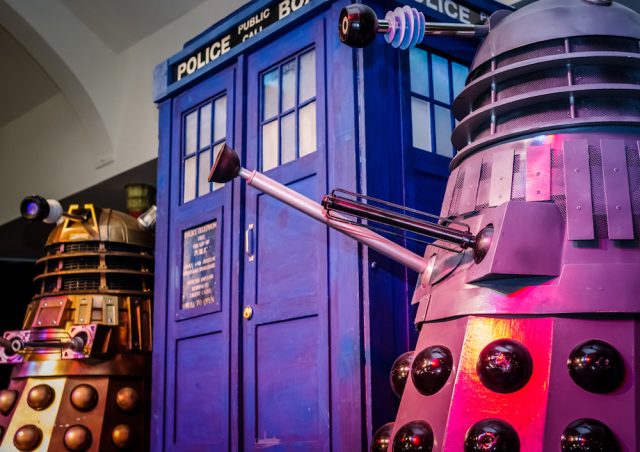This website uses cookies so that we can provide you with the best user experience possible. Cookie information is stored in your browser and performs functions such as recognising you when you return to our website and helping our team to understand which sections of the website you find most interesting and useful.
Discovering Doctor Who’s ‘complicated relationship’ with alcohol
To mark the 60th anniversary of Doctor Who, db caught up with author and expert Jamie Hailstone to discover the booze and pubs in the legendary BBC show.

It must be said the Doctor does has a complicated relationship with alcohol.
When the television series was originally devised in 1963, it was intended to be educational programme using time travel as a means to explore scientific ideas and key moments in history. It was allocated the Saturday evening ‘teatime’ slot around 5.20pm, so adult activities like drinking alcohol were strictly off the agenda.
But by the 1970s, times were changing and Doctor Who had developed a more adult ‘cult’ audience. The Third Doctor, played by Jon Pertwee, was something of a bon viveur with a penchant for crushed velvet suits, gadgets and fine dining.
“The early Doctor Who’s were not very keen on alcohol,” recalled Third Doctor producer Barry Letts in 2011 on The Day of the Daleks DVD. “But then if the shape of your nose is going to change, maybe your tastes change as well when you
regenerate.”
Famously, in the 1972 story ‘The Day of the Daleks’, the Third Doctor is seen leaning back and enjoying a glass of red, which he declares to be ‘most civilised and one after my own heart’.
Tom Baker
The James Bond-esque antics of Pertwee were followed by the Fourth Doctor, Tom Baker. On screen, the Fourth Doctor preferred jelly babies and Baker himself always tried to stay in character when children were around.
Off screen, it was a slightly different story and Baker was no stranger to the infamous drinking dens of Soho. In 1978, he gave an interview to Jeffery Bernard (of Jeffrey Bernard is Unwell fame) for the Sunday Times, when he mentions a few of his favourite haunts, including the Swiss Tavern, The Carlisle Arms, The Coach and Horses or the Yorkminster.
“After a few drinks the miracle is that one has something to say,” Baker told Bernard, who of course was no stranger to the odd tipple. “Then, no matter how I feel, I feel an obligation to feel no anxiety because of being recognised.”
During the 1980s, Doctor Who went through several regenerations, but as a hero to millions of children, he remained relatively clean living. The last words of the Sixth Doctor (at least on screen) were ‘carrot juice’, hardly a fitting epitaph for the great Colin Baker, who gave so much to the show.
When Doctor Who was taken off the air in 1989, we entered what is known as the wilderness years. But the Doctor’s adventures lived on in book form, thanks to Virgin Books. Many of these books explored more adult themes than the television series ever could, and many characters were free to drink again and partake in other pleasures. There were also a number of ‘unofficial’ straight-to-video dramas, featuring actors from the show, which also explored adult themes.
When the series returned in 2005 under the stewardship of Russell T. Davies, the emphasis was on fun for all the family again. Although having said that, the Tenth Doctor (David Tennant) claims in 2006 story ‘The Girl In The Fireplace’ to have accidentally created the banana daiquiri several centuries early while partying in 18th century France. Even after all these years, the Doctor still knows how to party.
Three legendary ‘Doctor Who’ pubs
In 1971, the Doctor Who production team descended on the Wiltshire village of Aldbourne for the Third Doctor (Jon Pertwee) story ‘The Daemons’. The story was filmed largely on location and is viewed as one of the all-time classics of that era.
In the story, Aldbourne became the fictional village of Devil’s End, and the local pub The Blue Boar, which first opened its doors in 1791, became the ‘The Cloven Hoof’.
In 1975, The Fox Goes Free pub in Charlton, near Goodwood in West Sussex, doubled for a remote pub on the Scottish Highlands for the Fourth Doctor (Tom Baker) story ‘The Terror of the Zygons’.
Later that same year, the picturesque village of East Hagbourne in Oxfordshire, was used for another Fourth Doctor story ‘The Android Invasion’. The village’s 17th century pub The Fleur De Lys, was one of the key locations and Baker and Elisabeth Sladen (Sarah Jane Smith) posed outside for publicity pictures.
Jamie Hailstone is an author and journalist, who was written short stories featuring the Third Doctor, the Brigadier and UNIT for Big Finish Productions and Candy Jar Books. He is also the author of Doctor Who – The David Tennant Years. An Episode Guide.
Related news
Stone Brewing to cease all international exports

